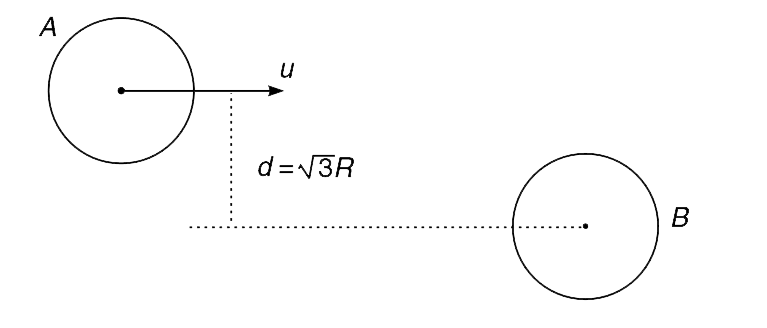Two balls of charges q1 and q2 initially have a velocity of the same nagnitude and direction. After a unform electric field has been applied for a certain time. The direction of the first ball changes by 60∘ and the velocity magnitude is reduced by half. The direction ofvelocity of the second ball changes by 90∘. In whata ratio will hte velociyt of the second ball change? Determine, the magnitude of the charge to mass ratio of the ball if it is equal to α1 for the firt ball. Ignore the electrostatic interactin between the balls.
 ,
,
Let the electric field on each ball be given by
E=Exˆi+Eyˆj
From the impulse-momentum equation, we have
Impules=Change in momentum
Let the final velocities of the ball be v1 and v2. Nothing that v1=v/2, we have
q1(Exˆi+Eyˆj)Δt=m1(v2cos60∘ˆi+v2cos60∘ˆi)−m1vˆi...(i)
q2(Exˆi+Eyˆj)Δt=m2(v2cos60∘ˆi+v2cos60∘ˆi)−(m2)vˆi...(ii)
On comparing the x and y-components on both sides of eq(i) we get
q1m2(Ex)Δt=−34υ and q1m2EyΔt=−√34υ ...(iii)
Similarly for Eq. (ii), we get
q2m2ExΔt=−v and q2m2EyΔt=−v2 ...(iv)
From Eqs. (iii) and (iv), by dividing the equation for x-components, we get
q1/m1q2/m2=34
or q2m2=43q1m1=43α1
Also q1/m1q2/m2=√3v4v2 or √3v4v2=34 or v2=v√3.
Topper's Solved these Questions
- COULOMB LAW AND ELECTRIC FIELDBook:CENGAGE PHYSICSChapter:COULOMB LAW AND ELECTRIC FIELDExercise:Exercises
Explore 58 Videos
- COULOMB LAW AND ELECTRIC FIELDBook:CENGAGE PHYSICSChapter:COULOMB LAW AND ELECTRIC FIELDExercise:Subjective
Explore 32 Videos
- COULOMB LAW AND ELECTRIC FIELDBook:CENGAGE PHYSICSChapter:COULOMB LAW AND ELECTRIC FIELDExercise:Single Answer Correct Type
Explore 22 Videos
- COMMUNICATION SYSTEMBook:CENGAGE PHYSICSChapter:COMMUNICATION SYSTEMExercise:QUESTION BANK
Explore 19 Videos
- Current ElectricityBook:CENGAGE PHYSICSChapter:Current ElectricityExercise:QUESTION BANK
Explore 40 Videos
Similar Questions
Give examles of variable velocity, when
(a) the magnitude is constant and the direction is changing
n (b) the manitude is cahnging and the driection remains the same
(c) both the magnitude and direction are changing
View SolutionGive examples of variable velocity, when
the magnitude is constant and the direction is changing.
View Solution
Knowledge Check
The first ball of mass m moving with a velocity u collides head on with the second ball of mass m at rest. If the coefficient of restitution is e, the ratio of final velocity of the second ball to the initial velocity of the first ball is
A1−e1+eB1+e1−eC1+e2D1−e2The first ball of mass m moving with the velocity υ collides head on with the second ball of mass m at rest. If the coefficient of restitution is e, then the ratio of the velocities of the first and the second ball after the collision is
A1−e1+eB1+e1−eC1+e2D1−e2A ball of mass 0.2kg strikes an obstacle and moves at 60∘ to its original direction. If its speed also changes from 20m/s to 10m/s, the magnitude of the impulse received by the ball is
A2√7NsB2√3NsC2√5NsD3√2Ns
A ball is thrown such that the time of flight is 5s and the horizontal range is 200m. Find the magnitude and direction of velocity of projection.
View SolutionGive examples of variable velocity, when
the magnitude is changing and the direction remains the same.
View SolutionA ball of mass m moving with velocity u impinges on a ball of mass em moving with velocity eu in the opposite direction. If the impact be direct and e be the coefficient of restitution then the velocity of the second ball after impact is the same as that of the first ball before impact.
View SolutionA smooth ball A travels towards another identical ball B with a velocity u. Ball B is at rest and the impact parameter d is equal to √3R where R is radius of each ball. Due to impact the direction of motion of ball A changes by 30∘. Find the velocity of B after the impact. It is given that collision is elastic

View Solutioncalculate the time taken by a spherical ball if the direction of electric field is reversed and the charge on the particle is changed to +3.5×10−19 C
View Solution